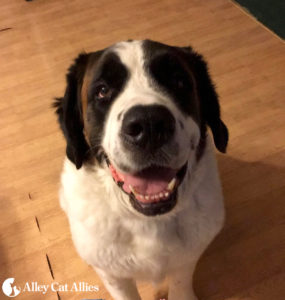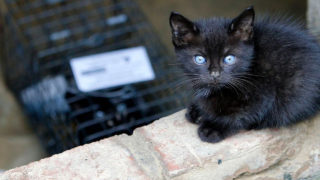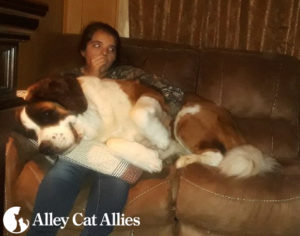In 2007, an indoor-outdoor cat named Pilot wandered from his family’s Santa Rosa, California, home. Despite desperate searches that went on for months, the family had lost all hope of finding him, and eventually moved to Longmont, Colorado.
On Oct. 31, 2017, a decade later, the family received an unexpected call: Pilot had been found among the wreckage of the California wildfires, according to a news report. He was taken to a veterinary clinic for treatment, where he was scanned for a microchip. It’s unknown how Pilot spent those intervening years, but thanks to the clinic’s prompt scanning, he was reunited with his family.

Bowser the dog at home thanks the Nebraska Humane Society, which makes scanning for microchips a top priority.
Happy endings like Pilot’s demonstrate the importance of microchipping and scanning both owned and community cats, as well as dogs. Alley Cat Allies’ Plan to Scan campaign highlights how quick, easy, and essential it is for animal control officers, shelter employees and volunteers, and veterinary staff to scan for microchips. This small handheld device, which can be kept at every counter, can save a life and reunite families in a matter of seconds.
Just a few months after Pilot was reunited with his family, Bowser the dog was brought into the Nebraska Humane Society amidst the cold and ice. He and his owner had been missing one another for two years, until shelter staff traced his microchip to a woman in Austin, Texas. Bowser’s owner was so excited that she drove the 12 hours overnight to get her boy.
The Nebraska Humane Society makes scanning a top priority. Their animal control officers have scanners in the field, so they don’t even have to take animals back to the shelter to scan them. For animals who are brought into the shelter, the intake staff scans them right away, and later scans them again upon intake assessment.
“We know that a simple scan can get a pet back home,” says Pam Wiese, Nebraska Humane Society vice president of public relations and marketing. “We never want to miss a microchip.”
For cats, microchipping and scanning is especially critical, as 70 percent of all catsand nearly 100 percent of community catswho enter shelters nationwide are killed. Studies show that microchipped cats are over 20 times more likely to be returned to their owners than cats who aren’t microchipped.
Here’s how it works: Veterinarians implant a microchip in the animal, which serves as a permanent ID tag. The microchip is registered with the owner’s information, so shelter staff or veterinarians will know who to contact if the animal gets lost and brought to them. It’s an animal’s ticket home.
Pet owners and community cat caregivers should remember to always microchip their animals and register them with up-to-date contact information. Microchips do no good if they aren’t registered. Changing your contact information every time you move, like Pilot’s and Bowser’s owners did, will keep you connected to your pet, even 10 years later.
Microchips also help reunite community cats with their colonies. Community cats can be microchipped with their caregivers’ information. If animal control officers pick up a community cat or someone erroneously brings one to a shelter, the cat can be scanned for a microchip and the caregiver can be contacted to return the cat to her colony.
In fact, scanning for microchips can prevent community cats from entering shelters entirely. If animal control officers scan cats in the field, as those from the Nebraska Humane Society do, they can see that community cats belong where they are and won’t take them to the shelter.
If community cats do end up in your shelter, don’t forget to scan them, even if they seem feral. More and more community cats are getting microchipped, like one cat who was brought into Clyde’s Animal Clinic in Mattoon, Illinois, in November. The very first thing Clyde’s does is scan for a microchip. This cat, the microchip revealed, was part of a Trap-Neuter-Return effort through a local spay/neuter van that partners with Alley Cat Allies. It turned out the cat was stray, not feral, and the clinic was able to track down her family. After two months of missing their cat, the family was thrilled to be reunited.
“The number one thing all clinics should do is scan every single animal right away,” says Connie Kille, office manager of Clyde’s Animal Clinic. “That’s our model. It’s second nature. And it saves lives.”
Alley Cat Allies has plenty of resources to help shelters and veterinary clinics with scanning and microchipping, including our sample shelter protocols, sample veterinary protocols, and how to scan a cat for a microchip guide.


